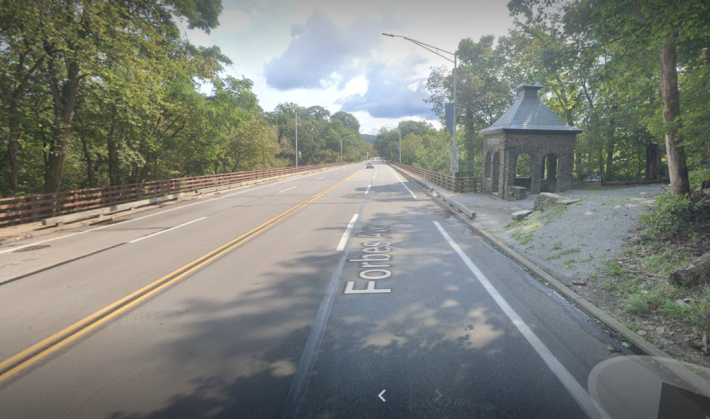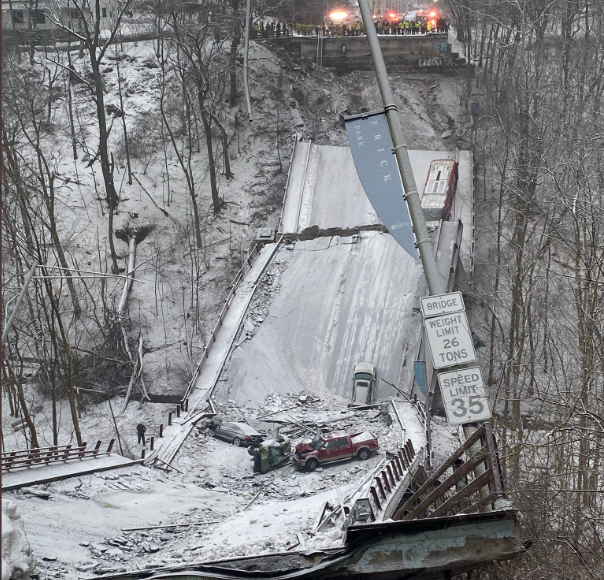A bridge collapsed Friday morning in Pittsburgh near the intersection of Braddock and Forbes, hours ahead of when President Biden was scheduled to travel to that city to talk about American infrastructure.
I finished a degree at Pittsburgh's Carnegie Mellon University in the summer of 2000. Even then, as someone who grew up in New York, I chose not to own a car and got around by bike, bus, and my feet.
During my two years in Pittsburgh ("The Paris of Western Pennsylvania" as I used to call it) I lived in Squirrel Hill where I could easily walk for groceries or a coffee. But when I was finally done with school and packing up my apartment to move to Los Angeles, I decided to rent a car for my last couple of days. That way I'd have it for necessary errands and I could drive myself--and my many suitcases--to the airport.
It was a beautiful, sunny afternoon and I decided to drive to a shop in a strip mall a few miles away to get packing supplies. As I drove home with a big bag of packing peanuts in the trunk, excited about my pending move and looking forward to a new life in California, I turned from Braddock west onto Forbes and started across the Fern Hollow Bridge.
I saw a flash out of the corner of my left eye and heard a loud bang. It was as if a giant hand had slapped the side of the car somewhere behind my left shoulder. My car spun around completely three times, still moving across the bridge and into the opposing lanes. Eventually, the spin stopped but I continued to move sideways. I looked to my right and there were two SUVs bearing down on me.
I remember being unsure if they'd be able to stop in time, before realizing it didn't matter: I was heading off the end of the bridge and into the woods and the ravine below. All that was left to do was scream in terror.
And then with a jolt that was even stronger than the original impact, the car stopped dead and all was quiet. The right front of my car had wrapped itself around a rusty steel electrical pole, which stopped me from going into the ravine. Somehow, despite all the damage and deformation of the rest of the car, my seat and side of the passenger compartment were left untouched.
I forced my door open and stumbled out. I looked at the 30-foot pole that had stopped me. I looked behind me and saw a crumpled yellow Toyota that had come to rest on the other side of the road. Its driver ran over and apologized for hitting me. "My brakes malfunctioned," he said. Other drivers came to make sure we were okay and said the Toyota's driver was going "like a bat out of hell."
From what they described, he had weaved his way through eastbound traffic on the straightaway on Forbes. Just before Forbes meets the bridge going East, there's a sharp turn. As I looked at all the tire marks and listened to the other drivers, I started to understand. The Toyota driver was going too fast to make that turn. He tried to brake but physics took over. He lost control, crossed the divider, and slammed into the back left wheel of my car, cracking the axle, and propelling the rear of my car perpendicularly to my direction of travel. At that point my car may as well have been moving on rubber skids; there was simply no way to control it.
An ambulance, tow truck, and the police showed up a few minutes later. I remember the tow truck driver, a burly guy in a short-sleeved blue uniform who looked like he could tow a car without the truck, kept looking at the remains of my car and shaking his head. "How are you breathing, let alone walking? You should go to the hospital," he said. The EMTs asked if I was okay and if I wanted to go to the E.R. I said I felt fine. They took my pulse, looked in my eyes; did the usual checks. "You should go to the hospital, you might have internal damage," said the tow truck driver. One of the EMTs turned to him and said "will you shut up."
The police officer looked at all the tire marks and listened to the accounts of the witnesses. I remember the Toyota driver repeating "my brakes locked up. They malfunctioned." But the police officer shook his head, saying "You can't drive across the double yellow line in the State of Pennsylvania" as he took out his citation book and started to write.
"But what about my brakes?"
I turned and barked at him: "The pavement's dry. Brakes don't just lock up. You were speeding."

I asked the EMTs if they thought I should go to the hospital. They just said they couldn't find anything wrong. But I took the tow truck driver's advice and went anyway. Everything seemed so quiet in the back of the ambulance. I couldn't believe what had happened; the one day in two years I rent a car and this! I thought about the bike lanes on Forbes. Just a painted stripe. If I'd been riding my bike that afternoon, I would have been turned inside out.
A doctor examined me in the emergency room and couldn't find anything wrong. So after about an hour of observation, they said I could go.
I walked out of the hospital and realized I didn't have a way home. I remembered the packing supplies were still in the trunk of the wrecked car, now on its way to a junkyard. And the movers were coming the next day. I still had to pack. I'd had enough experience with Pittsburgh's bus system to know I'd probably get home faster by walking.
So I started walking. It took an hour. It wasn't that far, but Pittsburgh is as hilly as San Francisco. Squirrel Hill, as the name implies, is way up.
As I climbed Pittsburgh's tree-lined streets, I noticed a lot of those old rusty poles like the one that stopped me from going into the ravine. Pittsburgh used to have an amazing surface rail system, perhaps rivaled only by Los Angeles's Red Cars. But as with so many cities in North America, it was all but destroyed in a colossal act of civic vandalism. The big steel poles that held the wires were all that survived. I thought about how I was walking through "streetcar suburbs" that were once served by the great Pittsburgh Railways. There were nearly 100 trolley lines, but only one remained, and it didn't go anywhere near where I lived.
How ridiculous was it that it was so hard to get packing supplies without a car in a city that was once covered with such a massive transit system? How absurd is it that a bridge in Pittsburgh that carried streetcars now carried four lanes of car traffic, with nothing for bikes but a little stripe in the gutter?
Little did I know as I walked the hills of Pittsburgh, trying to stop shaking, that a few months later I would be gathering signatures on the Santa Monica Promenade to get the Expo Light Rail line built on an abandoned streetcar line in Los Angeles. That's how I would meet the people who would go on to extend the Streetsblog network to California. It's how I ended up editing Streetsblog S.F.

That crash would continue to haunt me. For years, I woke up screaming from nightmares. The horrors of traffic violence don't just impact people who are physically injured. The tow truck driver was right: I was not okay. But it also shocked me into realizing just how absurd our cities are, where once-great transit systems have been replaced by land-use and a monomorphic, auto-uber alles set of policies that give people little choice about how to get around.
I finally got back to my apartment. My landlord was sitting on the stoop. She said a tow truck driver had stopped by to drop off some packing peanuts and they were waiting in my apartment.
It's astounding that nobody was killed in the collapse of that same bridge Friday morning. The President visited the site and talked about America's rusty bridges. "They’re going to fix them all," he said. Certainly, the collapse underscores that need. But what a tragedy it will be if the country just builds back a bunch of car lanes, and misses an opportunity to build protected bike lanes and restore the rail systems those bridges once carried that took people, safely, pollution-free, everywhere they needed to go.





